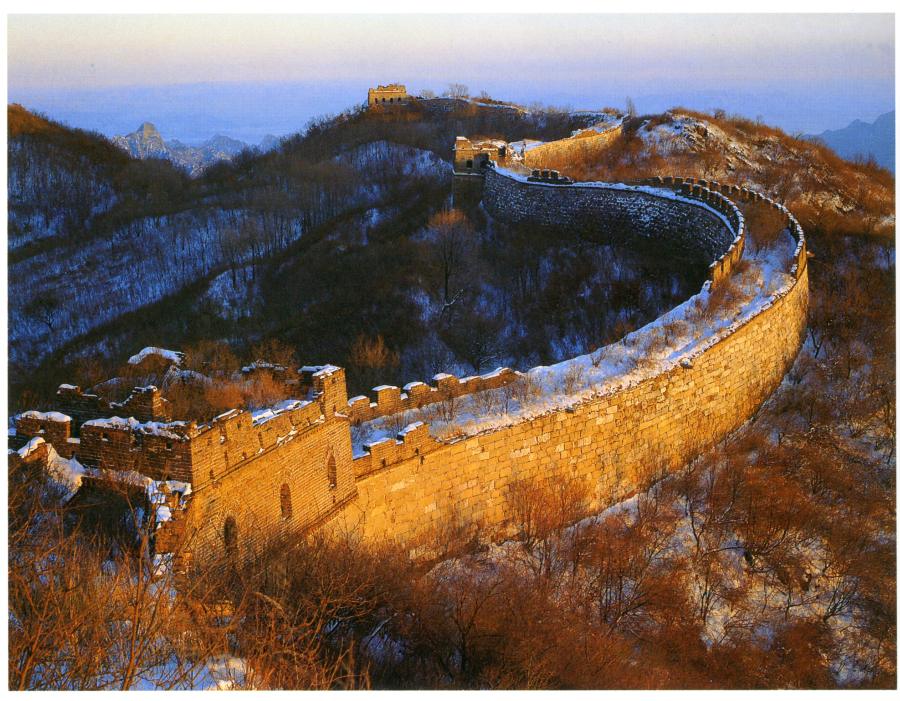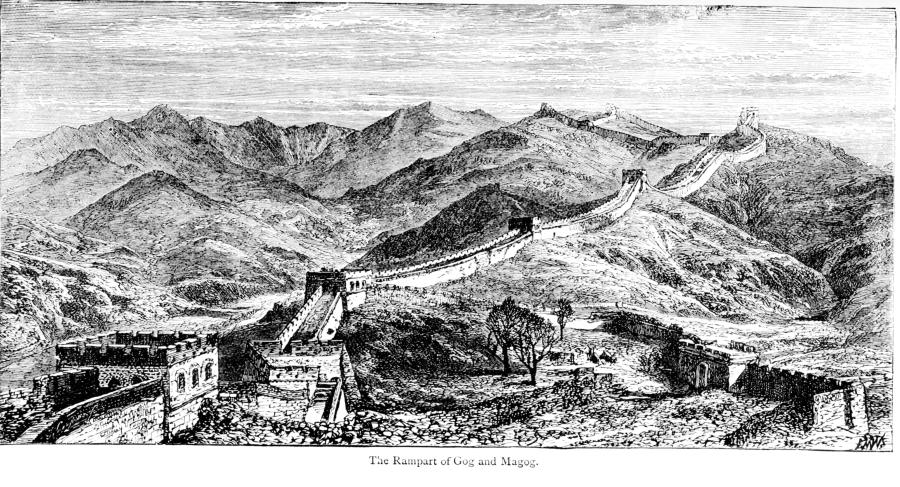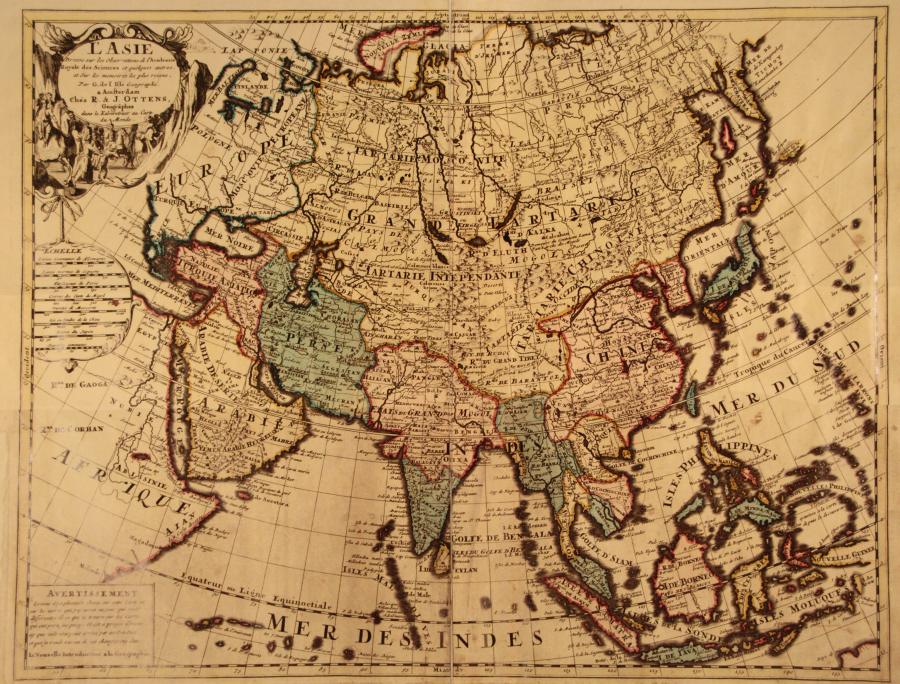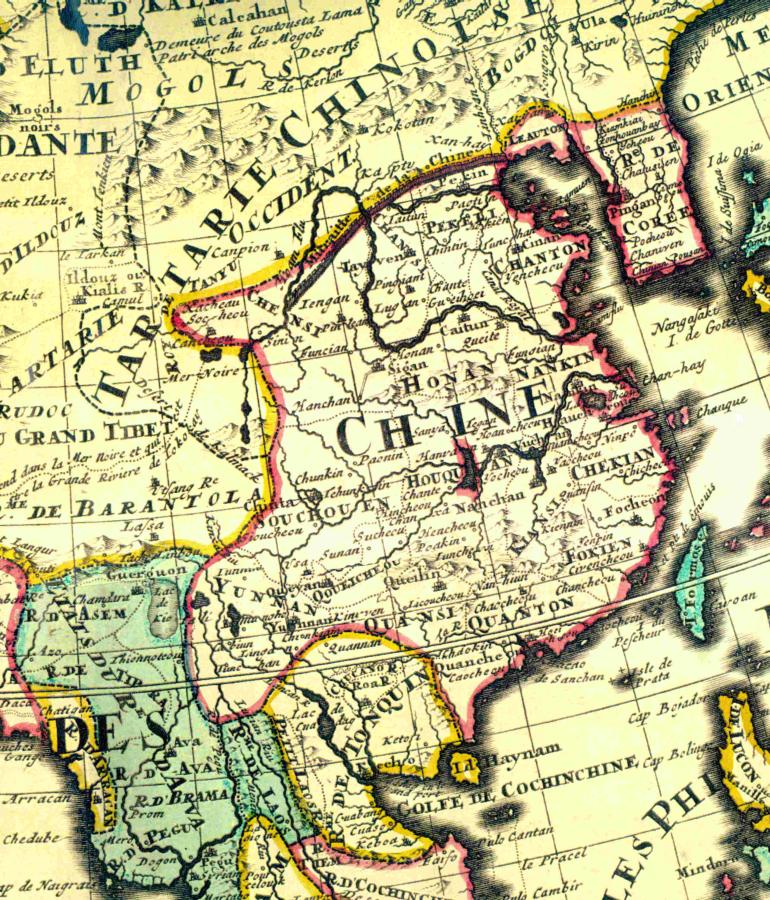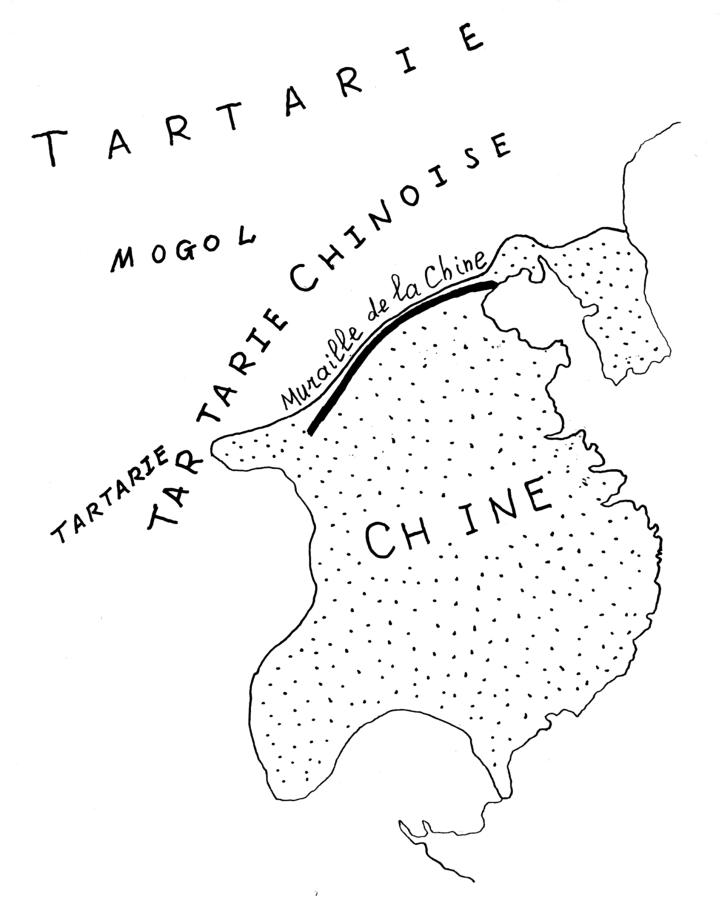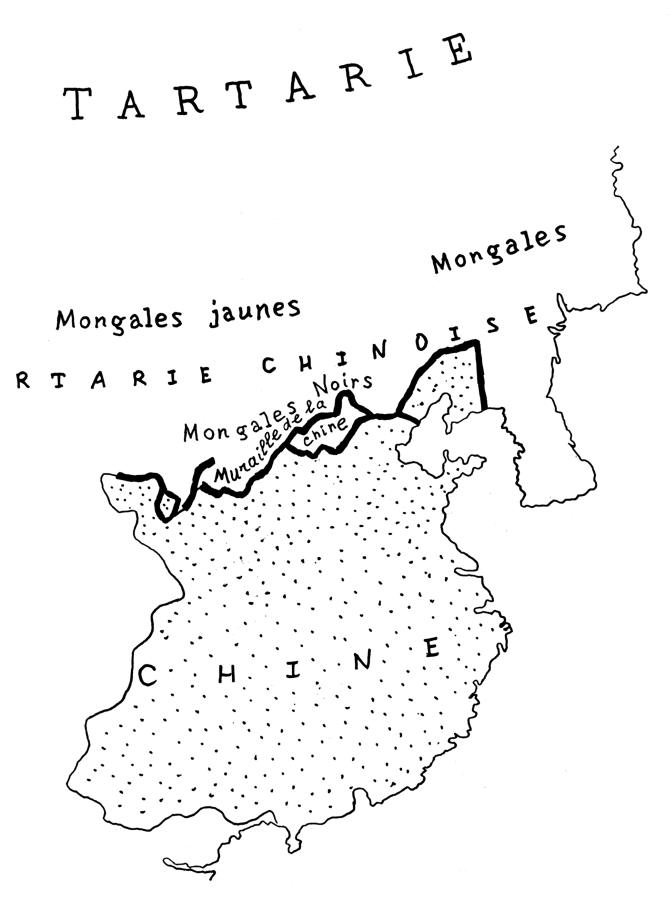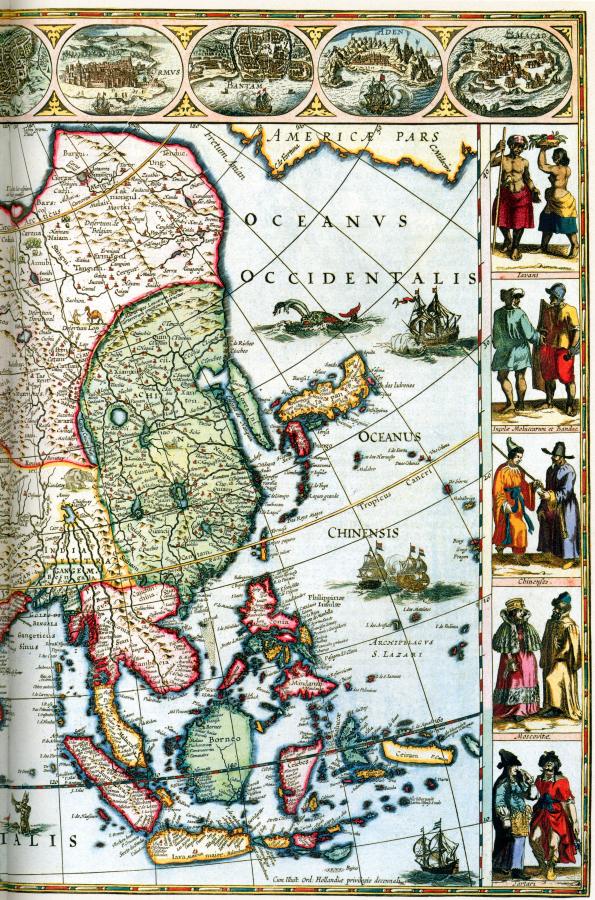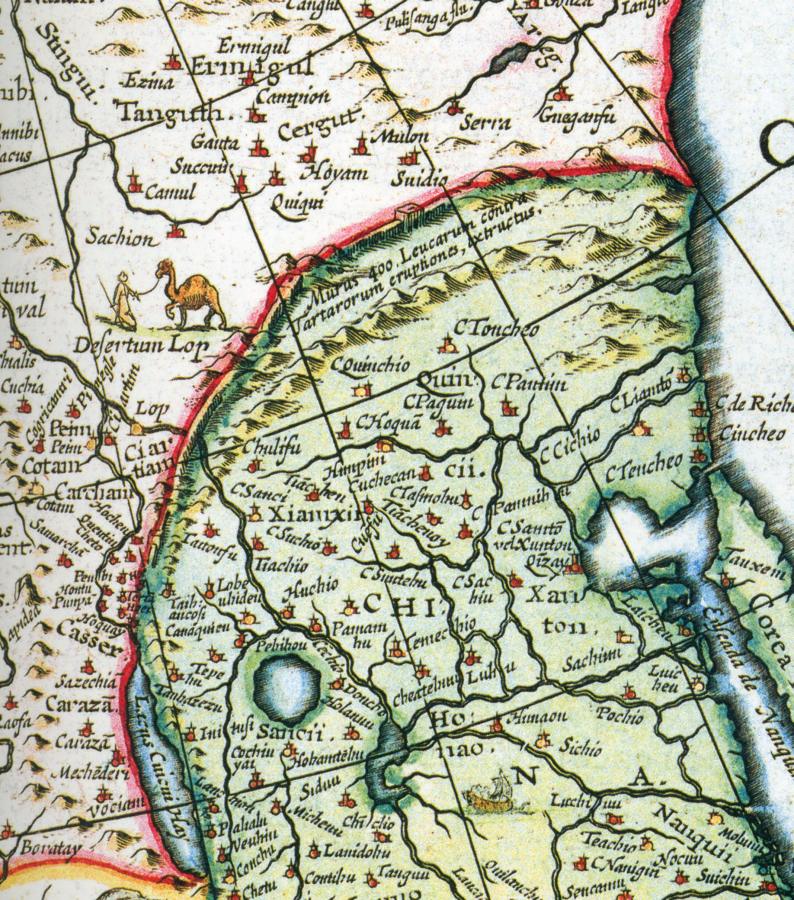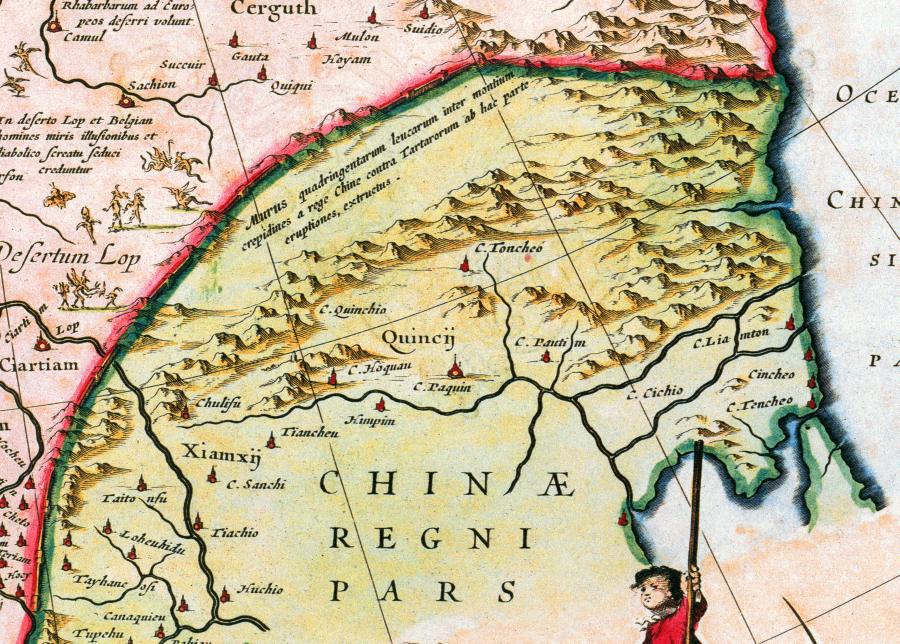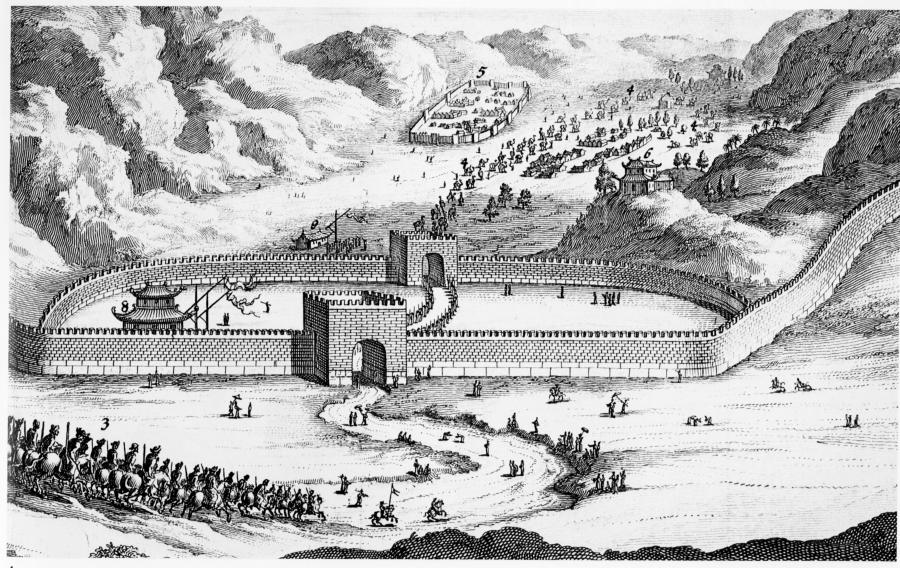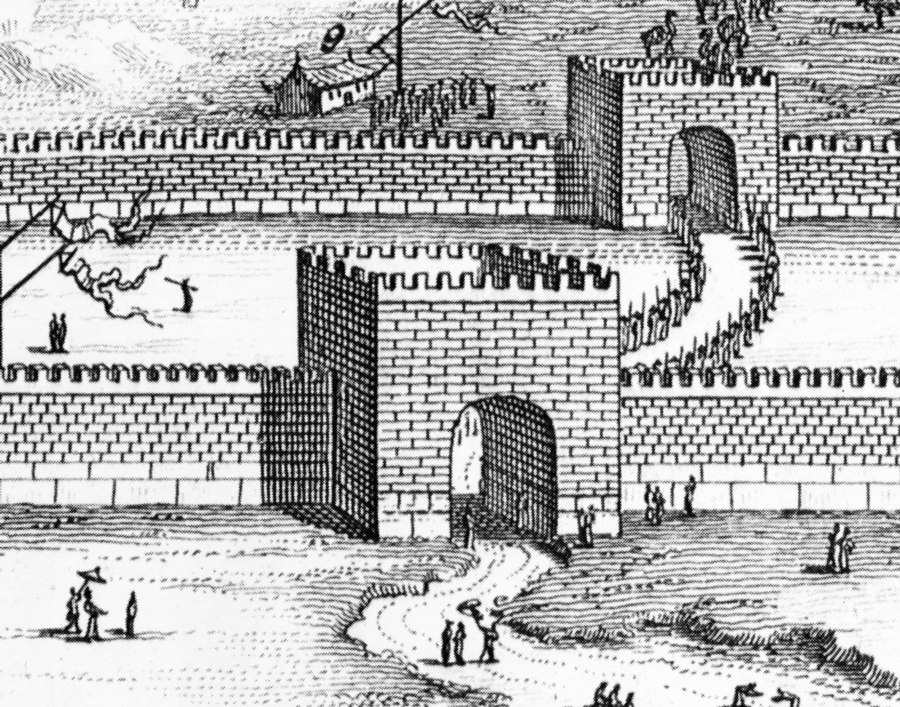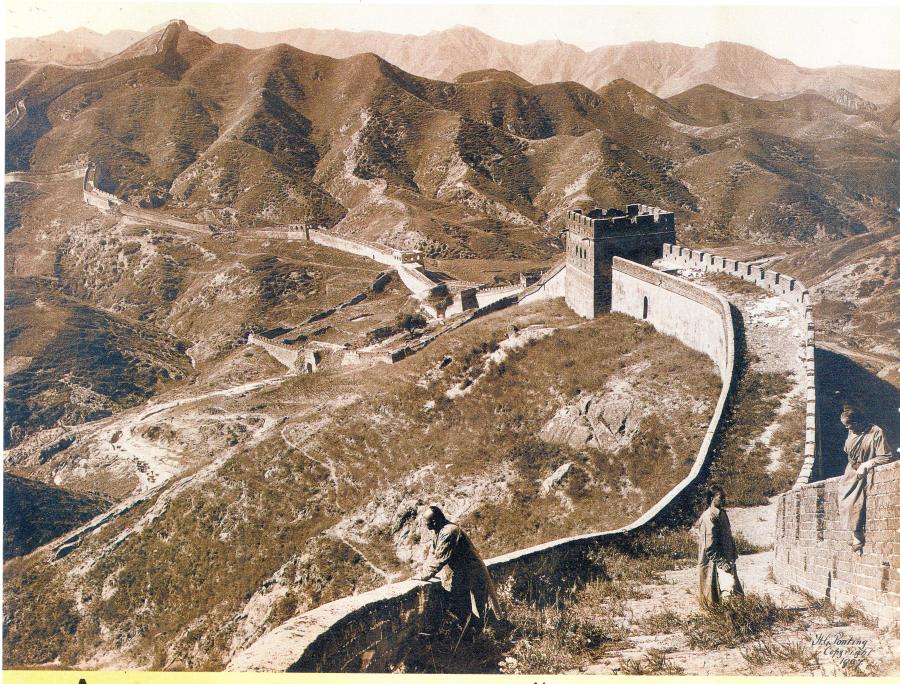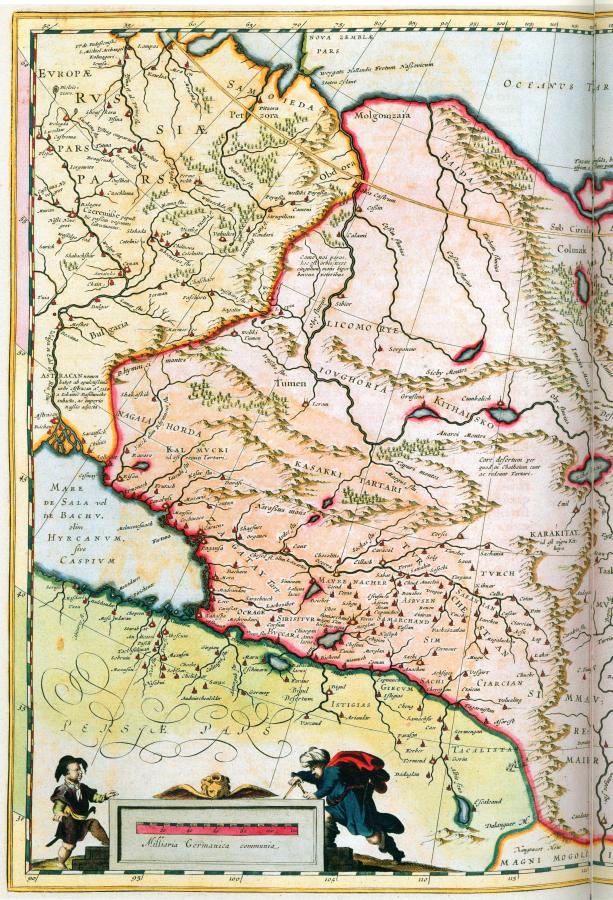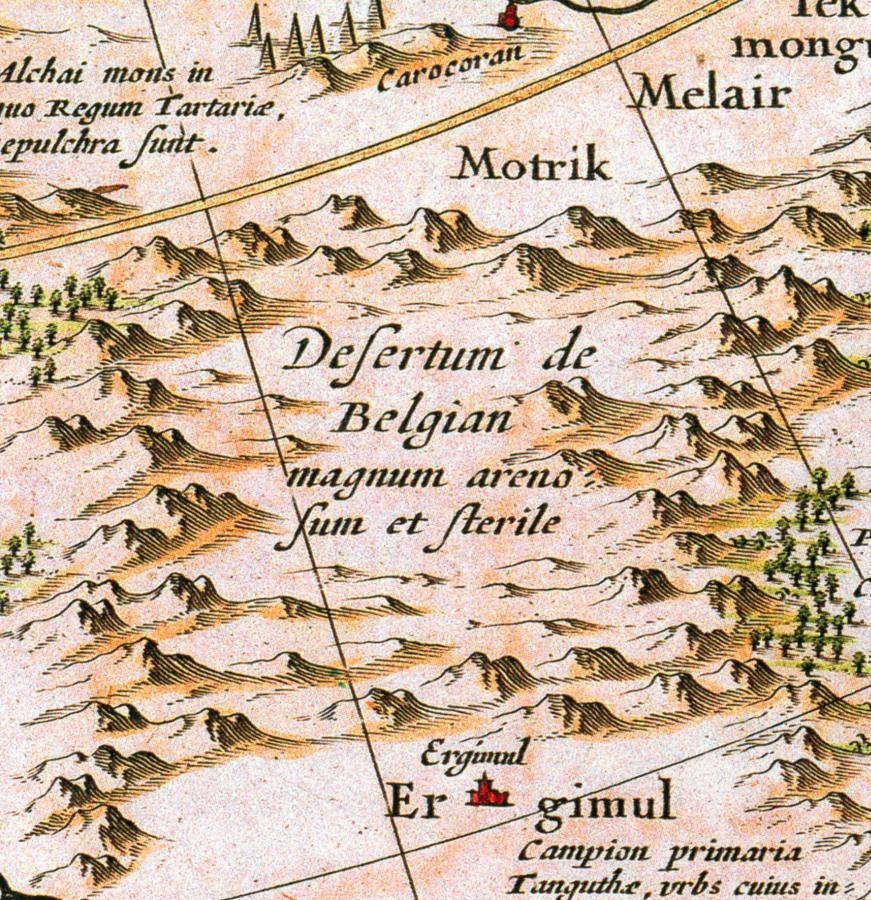Part 2.
China. The new chronology and conception of Chinese history. Our hypothesis.
Chapter 6.
Parallels between the history of Europe and the “ancient” China.
4. Chinese History of Cidanes, the Kingdom of the Prester John, and the Emergence of the "Mongolian" Empire
4.1. Copying on Paper of the Prehistory of "Mongolian" Empire to the European and allegedly Eastern "Chinese" History
Above we tried to show that the "Chinese history" before the XIV century AD is, in fact, a copy of the European history brought to China and mistakenly perceived there as "local Chinese history."
Continuing to move up the "Chinese history," we finally come to the XIII century AD - when even in the opinion of historians themselves "Chinese history" is connected with the European.
It is in this place that the Scaligerian version blends the history of China with the history of Europe. Here there is a vast "Mongolian" = The Great Empire, which includes both China and Europe, including Russia, the Balkans, Eastern Europe, etc.
If you move back to the "Scaligerian history textbook" from the era XIII century AD, into the past, we will see how it "bifurcates'' Nations. On paper, of course, for example, the" Mongols "will appear both in China and in Russia. However, we have already talked about the fact that "Mongols" means Great, the name of the population of Ancient Russia-Horde. Thus, the Scaligerian history doubles the "Mongol" = Russian ancestors, places them in "ancient" China, as "Mongols," and in Russ – as Russians.
The ancestors of the Huns, that is, the European Hungarians, historians place them in China as the Huns or Sunnis and in Europe - as the Huns. And so on.
If you listen to the historians, it turns out that the ancestors of all these Nations formerly lived in China, and only then spread from China throughout Asia and Europe. Roughly speaking, it turns out that today "we are all Chinese," the descendants either of Mongols or Huns, etc.
Our idea is entirely different. According to our reconstruction, history of China - at least before the XIVth century - is merely an Eastern copy of European history. In such case, it contains valuable details that later lost in Europe. Returning them "to their place," one can better reconstruct the medieval history of Europe comparing it with the "Chinese chronicles."
Therefore, the "Chinese history" seems to us exclusively valuable. The question is only in its correct interpretation. Described in it events "were in reality." But not always in China. Most often - in Europe.
From such a new point of view, it is interesting to see how was formed a "Mongolian" = Great Empire. Therefore we can reject ridiculous theories about the grandiose movement of wild nomads through the whole continent from China to Europe. A new point of view allows comprehension of many phenomena in the history of the "Mongolian" conquest, which in their consensual presentation are incomprehensible.
4.2. History of the "Mongolian" Empire in the "Chinese" Chronicles
4.2.1. Roman and Nicean Empires in the "Chinese" Chronicles
We continue to move up the "Chinese annals." We make use of a brief description of them, made by L.N. Gumilev [212].
We will immediately quote our version of the reading of the "Chinese" chronicles, identifying the events described in them with the European ones. We instantly see that such a "European reading," taking into account one, already done by us above, turns out to be entirely natural.
After the capture of the capital of China by the Jurchen, led by the king Altan, two Empires formed. That happens, in our opinion, after the Fourth Crusade, when the Francs-Latins captured Constantinople, hence the name Altan = Latin.
One is the Jurchen Empire, founded by foreign invaders, a reflection of the Roman Empire in the territory of Byzantium. The other is the Chinese Empire, founded by a new Emperor from the old Chinese, that is, Byzantine, Romean dynasty. The Chinese Emperor had to establish a new Southern capital [212], p.177.
This second, Chinese Empire mirrors, in our opinion, well-known Nicean Empire. It located on the territory of Byzantium. The foundation of the new Chinese "South Capital" - is the reflection of the foundation of the new Romean capital in Nicaea.
4.2.2. Ilya Dashi
In the north, the Jurchens, that is, apparently, crusader-Latins, appears an enemy - a kind of Cidan, that is merely Macedonian, Prince Ye-Liu Dashi. That is, most likely, the prince Ilya.
The following is reported. "Ye-Liu (Ilya - Auth.) Dashi was born in 1087 AD in the royal family of the Liao Empire. He was a descendant of the founder dynasty - Eluia Ambagan in the eighth generation "[212], p.177.
Elyui, Cidan = Macedonian prince, tried to resist invaders, but in the end, was forced to leave the country to the north together with loyal troops.
Three days later he crossed the "Black River" and was among the Onguts [212], p.180. Most likely, it is the Black Sea. Also, the Onguts are the Goths, as we already told you about. Goths, living, naturally, in Europe and in particular – in the Balkans.
After several days of long march, Ye-Liu reached a certain fortress Hotoon. In Europe, for example, in Belarus, traces of this ancient name - Hotoon may have been preserved. Say, the modern Khatyn or Katyn. It seems that these names originate from the root of Got, that is Goths or Hets.
4.2.3. Gurkhan
Ye-Liu Dashi took the title "Gurkhan" [212], p.180, and founded "Kara-Chinese" state [212], p.186. That is, as adds L.N. Gumilev, Yeluy (Ilya) Dashi became the KHAN. The next paragraph of L.N. Gumilev is also called the "Destiny of Khan."
In the "Chinese" title of Gurkhan, the combination of Gurgi-Khan, that is, Khan George. Note that Gurgi or Gurgia - is an old Russian form of the name after George - we already talked about this in detail in the book "The New Chronology of Russia." Why did Ilya-Ye-Liu take it such a title, we will now see.
It turns out that the descendant of Ye-Liu Dashi was, as L.N. Gumilev writes, "Djulhu (Jurka, that is, Yurka, Yuri! – Auth.), who ruled until 1213 AD. He was forced to get involved in politics related to the wars of Genghis-Khan "[212], p.191.
What odd names had some "Kara-Chinese" rulers? For example, the "Kara-Chinese" Emperor Yuri. Better yet - the "Kara-Chinese" Emperor ILYA = Ye-Liu.
By the way, the name Dzhurka, being read without vowels, sounds like GRK, that is, again, Georgia, Gyurgy, Gurgy. These ancient forms of names George or Yuri are very often mentioned in the annals, see the book "The New Chronology of Russia." As we have already shown, Khan George - was most likely: Georgy Danilovich or Yuri Moskovsky, he is also - Cenghis-Khan, idem Ryurik of Russian chronicles.
The principal result of his work is the creation of a vast Empire. It is known today under the name of the "Mongolian" Empire (founded by Genghis Khan) or Ancient Russia (founded by Ryurik). As shown in the book "The New Chronology of Russia," these are just two different names of the same State. It was bifurcated only on paper, as the result of chronological mistakes made when writing the world and Russian history.
So, we see that in the "Chinese chronicles" occurs certain confusion: the name of the famous khan George = Gurgi merged with the title of Khan. So, apparently, and there was a "new Chinese title" GURKHAN, which in the later annals were mistakenly called not only the right George but also the previous rulers of the "Kara-Chinese" state founded by Eliu = Ilya Dashi. Recognizing the name as a title, they used it for other persons. Let's return to the story of Ye-Liu-Ilya Dashi.
After fleeing from "China," there is, as we have seen, in fact from Byzantium or Russ-Horde, - Elyui Dashi "gathered his commanders, - L.N. Gumilev tells us, - and addressed them a speech. He acknowledged the defeat of his People, the catastrophic disintegration of the Liao Empire (that is, the ROMEA-Byzantium. Auth) and told about the flight of the last Emperor. He declared to them his intention to unite the Nomadic tribes of the great steppe for the reconquest of the native land "[212], p.185.
We recognize a well-known from the history of Russia political program of creating a unified "world kingdom" by military means, see the book "The New Chronology of Russia." The program of Ye-Liu Dashi was later realized by "MONGOLS," that is, the Great Ones. It happened in the XIVth century, about a hundred years later. The beginning was laid down by Genghis Khan = George Danilovich, alias Ryurik, and completed by his brother (and not his nephew, as is commonly believed) – Khan Batu = Ivan Danilovich Kalita (Caliph).
Probably the Danilovich brothers were the direct descendants of a runaway Macedonian = "Cidan" = Cidan Prince Ilya = "Ye-Liu Dashi "from Romea-Byzantium.
4.2.4. "Chinese" Imil and Ancient Russian River Ilmer
Ye-Liu Dashi first founded his own, at that time small state in the valley of the river Imil [212], p.185.
That is what is said about this in the "Cara-Chinese" history. "Cidans held the valley of rivers of Imil, and in Semirechie (seven rivers), where they took part in the fight of the Kangal and Karluks with the Khan of the Balasagun City "[212], p.185.
We do not know whether there is today in the East, China, Mongolia, "the river Imil." We did not find it on the map. However, to find "the river Imil "in the territory of ancient Russia is simple.
Maybe it is the river ILMER, wherefrom prince RYURIK came, allegedly, "being called to Russia," according to the counterfeit sheet in the Radzivil Chronicle. Perhaps Imil is Itil, that is, the river Volga.
4.2.5. "Chinese" City Of Balasagun And Old Russian City Of Balakhna
Along with the "river Imil" "Chinese" chronicles call the city Balasagun. Where was it located? Again, we could not find in modern "Small Atlas of the World" (M., 1979) the city of Balasagun somewhere in the East, in China or Mongolia.
The search for "the city of Balasagun" in Russia did not take long. We all know the big city of BALAKHNA on the Volga, above Nizhny Novgorod. Moreover, some scientists, for example, P.P. Smirnov, considered Balakhna one of the capitals of ancient Russia [754], p.178.
In the name of Balakhna, the combination of the roots «white» and «khan». Just like in the "Chinese" name of Balasagun, that is «white hun» or white Khan. It turns out that in Russian history the name Balasagun is present almost in the same form as Balgasun. So, according to the legend, the Khan Baty called so the city of Kozelsk he has taken. As Tatishchev writes, "MauBalgasun" meant "Kalmyk" as an "evil city" [832], part 2, p.237. Thus, Balgasun is the Turkic name of the Russian city, same as in the "Chinese" chronicles. Maybe it was Balakhna city.
4.2.6. "Chinese" Semirechie-Seven Rivers
In the book "The New Chronology of Russia," we have already hypothesized that the famous "Chinese" Semirechie meant the seven rivers or "family of rivers," where settled Cossacks. These were: Volga, Don, Yaik, Dnieper, Dniester, Terek, and Irtysh. Let us also recall the existence of in Russia of Semirechie Cossacks. Moreover, reading the "Chinese" story of Elijah Dashi, we again will meet with Semirechie - seven rivers.
4.2.7. Ilya Dashi Becomes A Chief Of A Huge Army In The Semireche
Settled in the Semirechie "on vast pastures" [212], p.185, Ilya-Elyui Dashi after a while suddenly becomes the chief of a huge army. L.N. Gumilev wrote in astonishment: "From 1130 to 1135 the force Ye-Liu Dashi increased to a huge number but at the expense of what and whom?" [212], p.187.
It turns out, as Ibn Al-Athir reports, "in 1130 the Karluk and the Guz mercenaries quarreled with the Samarkand ruler Arslan-Khan and fled to Gurkhan "[212], p.187.
The Guz have already been identified as Kazaks on the basis of entirely other data in the book "The New Chronology of Russia."
Samarkand - probably a slightly distorted name of the famous Russian the city of Samara on the Volga (Samara-Khan), or Sarmatia-Scythia.
Arslan-Khan means Ruslan-Khan or Russian Khan. Many Volga Turks still have the name Ruslan. Recall common in Russia surname Ruslanov.
Thus, all the names and locations in the "Chinese" annals can be found consistently in ancient Russian history. In our opinion, here we see the beginning of Russia's unification under the rule of the future Russian Horde dynasty. We are at the beginning of the creation of the "Mongolian" = Great Empire.
4.2.8. About the Name China. Why China Is Called China
Scaligerian dating of allegedly Chinese events, about which discuss here is around 1130 AD. However, taking into account the already discussed century shift as mentioned above, they fall into the middle of the 13th century AD. Probably, this is the correct date.
At that time, Byzantium split into the Latin and Nicean Empires, and in Russia begins the process of unification. Probably the name Kitai (China) - is one of the variants of the pronunciation of the word Skifia or Scithya, viewing of the transition of F (the letter fita) to T. It is possible that the Russ-Horde was called the state of Kara-Kitai. Therefore, until now the ancient name Kitai-Gorod (China-City) exists in Moscow, i.e., the second belt of military fortifications around the Moscow Kremlin. Kitai-Gorod (China-City) survived in Moscow until the 20th century. Its high walls were dismantled only at the beginning of last century, after the revolution of 1917.
Remark: N.A. Morozov rightly noted that nowadays the name KITAI has been preserved ONLY IN RUSSIA. Of course, today the Russians still call modern "China" – Kitai, but apart from us, nobody calls China KITAI. As, incidentally, the Chinese themselves do not CALL them KITAIS. In Russian language, China has become known as "Kitai" only after the XVII century. Look up in the "Dictionary of the Russian language XI-XVII centuries" (M., Science) the word Kitai as the name of the state is GENERALLY ABSENT. Modern China before the XVII century in Russia was still called BOGDOY. In Russia Kitai even as late as the XVII century was called the "Bogdoy" kingdom. More about this below.
On the other hand, in old documents, we encounter from time to time the KARA-Kitai state or the state of Presbyter John. The question is, where is it? Methinks it is Ancient Russ, dating back to the 13th-14th centuries AD. After the Unification Wars of Ivan Kalita, Ancient Russia expanded and became known to foreigners, i.e., Western Europeans as "Mongolian" = Great Empire.
However, one of the own names of this state or some part of it was the name "Kitai" = Skitia = Scythia. Therefore, in the Russian language are still found the traces of old Russian words:
Kitai-town, Kitaika - pure cotton fabric, as well as a variety of apples are still present. Recall also - kita- the old name for something retinue, woven, etc.
In general, kita is the old Russian word. Today it is no longer used, but until the XVIIth century, it was common in our language. As reported, for example, in the "Dictionary of the Russian language XI-XVII centuries," the word kita means something woven, bound in a bundle, in a braid [787], p.141. In particular, kita meant a pigtail, a tourniquet, headdress from feathers. The author of the XVII century writes: "The hats [Janissaries] had kitas." [787], p.141. Thus, kita meant a part of the military garment. The word kita, with the same meaning, exists in other Slavic languages, for example, in Polish [787], p.141.
Note that the word kita meant part of the military uniform, in particular - Russian. For example, gusars were wearing the kitas - high sultans on hats. Habitual today the word "sultans" came to be used much later, and in the XVII century, they were still called the old way - the kitas. It can be seen, for example, from the following quotation taken from the source of the second half of the XVII century, which describes military uniforms: "The horse is an equine, and the saddle is gusar's ... the horseback cover is sewn with gold kita, feathers the same "[787], p.141, that is, the kita made from the same feathers.
Even on the modern monument to Bogdan Khmelnitsky in Kiev, you can remark a kita - a sultan of feathers on a turban. Turkish warriors wore a turban, high Sultan-KITA. It is possible that the word kita, which meant part of the military equipment, preserved in the name of "Cidans" - Macedonians (Kita = Cida), who came once to the Balkans from the Russ-Horde. At the same time, there is a story of Chinese chronicles about Cidan prince Ye-Liu Dashi – which with "European" reading becomes a story that a certain Macedonian = "Cidan" military detachment of Prince Ilya = "Elyuya" came to Russ from Byzantium in the XIIIth century and founded there the state that grew up subsequently into the "Mongolian" = Great Empire = medieval Russia.
Now it becomes clear why the smooth single-colored cotton fabric is called kitaika [787], p.142. After all, it was produced in Russia - the "land of Kitai (China)." By the way, it is believed that from the same word Kitai, came the name of the famous Kitai Gorod (town) in Moscow [85], v.21, p.313.
It is possible that the so is called Moscow fortified army camp - "the town of Kitai warriors."
The word kara from the combination of "Kara-Kitai" is, most likely, just Kir or the king. We recall the transitions of "C" into "K" of Caesar-Kaiser type. Consequently, the Kara-Kitai state turns out to be merely kingdom Kitai, that is, the Royal Skitia = Scythia. It is also the kingdom of Presbyter John, consequently, Ancient Russia-Horde = Great Empire.
In the following chapters, while analyzing Scandinavian maps, we find that Skifia was also actually called Kithium, that is, Kitai (China!). See Part 6. Therefore, we repeat, Kitai (China) is just slightly distorted name Skifia.
4.2.9. Grandiose "Ancient Chinese" Battle In XIIIth Century AD
We return to the story of Elijah = "Yeshua" Dashi in Chinese sources. "In 1141, a new conflict arose and this time of grand dimensions. To fight the infidels (that is, Ilya-Eliyu – Auth.) Sultan Sanjar decided to send the best troops of the Muslim world, hardened in battles with the Greeks and Crusaders, armed by the last word of the technique of that time. The army of Sanjar was estimated at approximately one hundred thousand riders. So many troops were not sent even against the crusaders. The Sultan and his entourage looked at the operations extremely seriously, and not just as to the defense against the regular raid of the Nomads" [212], p.187-188.
Ilya-Ye-Liu Dashi, according to Ibn Al-Asher, put three hundred thousand warriors "from the Khitan, the Turks and the Chinese" [212], p.188.
The battle took place in 1141, that is, in approximately 1241 - with a hundred-year shift. It took place on Katwanaook plain situated between Khojent and Samarkand. "Ilya-Ye-Liu Dashi divided his army into three parts and completely crushed the army of Sanjar, better than could any Karl Martell, nor Lion Isavr, nor Gothard Bullion. Thirty thousand of the best Seljuk warriors met the death of the brave. That is the fact! Well, the fact that it happened is without doubt, but why it could happen, is incomprehensible and not explained. After such a brilliant victory Ye-Liu Dashi limited himself with the occupation of Samarkand and Bukhara, and some Khitan detachment plundered a Khorezm oasis. Chah of Khorezm, however, quickly concluded with Gurkhan, pledging to pay some taxes. In all those cities captured
by the Khitan stayed the local rulers, who were only obliged to pay taxes to Gurkhan "[212], p.188.
What did we learn from that? We learned the following:
a) 1241 AD - practically coincides with the Miller-Scaligerian year of the conquest of Russia by "Mongols."
b) The grandiose battle probably with a centenary shift was either the famous battle on The Kalka in 1223 or the battle of Iver City 1238, in which "Mongols" = the Great defeated the combined forces of the princes who fought against them. Both parties were Russian. (sic!)
c) "Mongolian" custom to leave in captured cities their former rulers and only impose tribute, is well known. We see the same thing in the "Kara-Kitai (Chinese) conquest."
By the way, Ilya-Ye-Liu Dashi divided his troops into hundreds. "Sotniks, i.e., the heads of hundreds, i.e., centurions obeyed directly to Gurkhan "[212], p.189. The Cossack troops were divided into hundreds, and the Cossack centurions are very familiar to us.
4.2.10. The Christianity Of Kara-Kitai (China). The Czar Skifs?
Founded by Il-Liu = Elyuya Dashi, the state of the Kara-Kitai was Christian. For Scaligerian historians, this looks very strange. Why did the Far Eastern nomads suddenly find themselves Christians, not Muslims or adherents of some eastern religions? Moreover, the Kara-Kitai (Chinese )(Czar Scythians?) On the one hand they seem to be Christians, and on the other, Muslims. The confusion is complete.
Here what L.N. Gumilev says. "Despite his (that is, Ye-Liu Dashi - Auth.) a letter to the governor of Bukhara, starting with a formula acceptable to Muslims ... his heir received the Christian name of Elias, and the Crusaders in Palestine and Syria Sincerely Believed in the Existence of the Christian Kingdom on the East from Persia (not from France? - Auth.) "[212], p.190.
Also, the son of Ye-Liu Dashi was called Ilya. Moreover, he was CHRISTIAN. However, it turns out that the "Chinese" records considered the successors of Dashi as the very same Dashi [212], p.191. In other words, Ye-Liu Dashi and his "son Elijah" is the same person. However, then Ye-Liu Dashi turns out to be a Christian by the name of Ilya. Correct. Nobody one else could have been.
Here it is, apparently, the real history of the Orthodox Ancient Russia that was also the CHRISTIAN kingdom of Presbyter John. About it, we will talk in detail in the next part.
4.2.11. "Chinese" Chronicles, Talking The Same Time, Were Elongated By A Century
Ye-Liu Dashi died in 1143. Then his successors ruled, although the "Chinese" sources for some reason considered as the very same Elyuya Dashi [212], p.191. "In 1178, the son of Iliu Zhulhu (Jurka, that is, Yurka, Yuri - Auth.), took the throne. He ruled until 1213 but was forced to get involved in the politics associated with the war of Genghis." [212], p.191.
After that, the state of the Kara-Kitai (Chinese), Czar China, was included in the "Mongolian" Empire.
Our explanation is as follows. The chronologists stretched out the time of the government of one Ye-Liu-Ilya Dashi by several decades more than required.
Also, it is understandable why. They could not meet the ends of the chronology because of the centenary shift. Moreover, the chronicles still talked about one Ye-Liu.
They had to "multiply" (on paper, of course) single Il-Liu Dashi into several ones. Moreover, then the son of Ilya - Georgy, Yuri appears. With a hundred-year shift, he falls on George Danilovich. It is still the same Genghis-Khan.
Since the era of Genghis Khan, we are entering here in the "Mongolian" Empire, that is, in ancient Russia epoch. Moreover, from that time all the essential events take place already on the Volga, in the Golden Horde. Thus, in Scaliger history, the events were transferred from the borders of modern China - to the Volga. Moreover, in our reconstruction, the action still unfolds in Kitai (China). But not in the contemporary, but in Russia. Which was sometimes called in that time Kitai (China) = Scythia = Skitia, see Part 6.
4.2.12. When Were The European Chronicles Transplanted To China?
It turns out that no earlier than the XIV century. Since, as we see, they describe the events of the XIII-XIV centuries, which took place in Europe. In this, we agree with N.A. Morozov, who wrote, based on very different reasons that the Chinese chronicles were written at the earliest in XVth century and planted there by Europeans. Most likely, Catholic missionaries.
5. The History Of China After The XVth Century
5.1. When, Why And Who Built The Great Chinese Wall
Today it is believed that the Great Wall of China began to be built in III century BC for protection from the northern nomads. Its modern state is shown in Fig.6.2 and Fig.6.3. On this N.A. Morozov wrote: "The very thought that the building of the famous Chinese wall, with height of 6-7 meters, and a thickness of three, stretching for three thousand kilometers, began in 246 BC by the Emperor Qin Shi Huang and was finished only after 1866 years, by 1620 AD - is ridiculous, a sheer disappointment for a serious thinker- historian. After all, every large building has a predetermined practical purpose. Who would have come up with the idea of starting a massive structure, which can be completed only after 2000 years, and until then will be just a useless burden for the population. And to survive so well till today. The Great Chinese wall could not be more than several hundred years old" [544], vol.6, p.121-122.
We will be told that the Wall was repaired in the course of two thousand years. It is doubtful. Repair makes sense only for not a very old building; otherwise, it is hopeless as it will become obsolete and just fall apart. What we observe, incidentally, in Europe. The old defensive walls were dismantled, and new ones were built in their place, more robust. For example, many military fortifications in Russia were rebuilt in the XVI century.
Nevertheless, we are told that the Chinese wall was built nearly two thousand years. They do not say that "the modern wall was built recently on the site of the ancient." No, they insist that the wall that was built two thousand years ago. In our opinion, this is extremely strange, to say the least.
When and against whom did they build the wall? Since, as we have already noted, the "ancient Chinese" history unfolded in reality In Europe before the XVth century, the Chinese wall was built not earlier than the XVth century AD.
They built it, of course, not against arrows and spears with copper or even stone tips of the III century BC. The stone wall thickness of about three meters is not needed against such weapons. Such walls are required for firearms. The construction of such structures began not earlier than the XV century when on the battlefield appeared guns and bombards.
For example, Ottomans = Atamans took Constantinople with the help of powerful siege guns. In Figure 6.4, we present one more image of the Chinese wall. It is fascinating that the ancient authors called it also the wall of Gog and Magog [1078], vol.1, p.294. So claimed, for example, Arab historian Abul Fida.
Against whom did they erect a wall? We cannot answer accurately. The answer requires additional research. However, let us state the following hypothesis. The Great Wall of China was built primarily as a construction, indicating the border between the two countries: China and Russia. Of course, it was regarded as a military defensive structure but hardly used in this capacity.
The defense of the 4000-kilometer wall [213], p.44, from the attack of the enemy makes no sense, even if it stretches "only" to one or two thousand kilometers. The wall in its current form does not quite reach 4 thousand kilometers.
L.N. Gumilev quite rightly wrote: "The wall stretched for 4 thousand km. Its height reached 10 meters, with watchtowers every 60-100 meters. But, when the works were finished, as it turned out, that all the armed forces of China were not sufficient to organize effective defense on the wall (how come they didn`t think about it before the beginning of construction - Auth.). If one puts a small detachment on every tower, then the enemy will destroy it well before the neighbors manage to give help. If you put bigger detachments, but more rarely, then gaps are formed through which the enemy easily and imperceptibly penetrates deep into the country. The fortress without defenders is not a fortress "[213], p.44.
What is the difference between our point of view and the traditional one? We are told that the wall separated China from the nomads to secure the country against their raids. But, as L.N. Gumilev correctly noted, this explanation is doesn`t withstand criticism. If the nomads wanted to cross the Wall, they quickly would have done it. And not once. And in any place.
We offer a radically different explanation. We believe that the Wall was built primarily as a boundary between two states. The Wall was made when the countries have reached agreement on this border. Apparently, to exclude border disputes in the future. And such arguments, probably, existed. Today the agreed parties draw a boundary on the map (that is, paper). And they think that this is enough.
And in the case of Russia and Chinese, the Chinese seem to have considered the treaty so crucial that they decided to perpetuate it not only on paper but also "on the ground," having built the Wall along the agreed border. It was more reliable and, as considered the Chinese, will permanently exclude border disputes. In favor of our assumption is also the length of the Wall itself. Four, or one or two thousand kilometers, is typical for the border between two big states. But as a purely military structure – it's pointless.
But after all, China's political border has changed many times during allegedly more than two thousand years of its history. So they tell us the historians. China merged, then collapsed into separate areas, lost and acquired some land, etc.
On the one hand, this seems to make it difficult to test our hypothesis. But, on the other, on the contrary, we are given the opportunity not only to check it but also to date the construction of the wall. If we can find a political-geographical map, on which the border of China will run along the GREAT Chinese wall, this will mean that precisely in this time the wall was built.
Today, the Chinese wall is inside China. Was there a moment when it denoted the country border? And when did this happen? It is clear that if it was built as a boundary wall, then at that time it went precisely along China's political border. This will allow us to date the construction of the Wall.
Let's try to find a geographic map, on which the Chinese wall is shown precisely along the political border of China. It is essential that such maps exist. And there are many of them. Those are the maps of the XVII-XVIII centuries. And we already used them in our book when we talked about geographical notions of the XVIII century.
We take the map of Asia of the XVIII century, made by the Royal the Academy in Amsterdam:
L'Asie, Dresse sur des observations de l'Académie Royale des Sciences et quelques autres sur les mémoires les plus récents. Par G. de l'Isle Géographe a Amsterdam. Ches R. & J. Ottens, Geographes dans le Kalverstraat au Carte du Monde. The map was taken from a rare atlas of the XVIII century [1019]. See Fig.6.5.
On the map, we find two states: Tartary - Tartarie and Kitai (Chine). See Fig.6.6 and the drawing in Fig. 6.7. The northern border of Kitai goes along the 40th parallel. Precisely on this border runs the Chinese wall. Moreover, on the map the Wall is drawn as the solid line with the inscription Muraille de la Chine, that is "high wall China "in French.
The same Chinese wall, and with the same inscription on it, we see and on another map of 1754 – Carte de l'Asie, taken from a rare atlas of XVIIIth century [1018]. See Fig.6.8. Here the Chinese wall is also going approximately along the border between China and Great Tartary, that is, Mongol-Tartary = Russia. See Fig.6.9 and the drawing in Fig. 6.10.
Literally, the same thing we see on another map of Asia of the XVII century, in a known atlas of Blau [1035]. See Fig. 6.11. The Chinese wall goes precisely along the Kitai border, and only a small western section of the Wall is inside Kitai (China).
In our favor speaks the fact that in general, the cartographers of the XVIIIth century placed the Chinese wall on the political map of the world.
Consequently, the Wall has the meaning of the political boundary. After all, the cartographers have not shown on the map other "wonders of the world," for example, they did not show Egyptian pyramids but the Chinese wall they did.
The same wall is depicted on the color map of the Zing Empire in the second half of the XVII-XVIII centuries in the academic 10-volume World History [151], p.300-301. On this map, the Great Wall is depicted in detail, with all of its small bends in the terrain.
Almost on its entire length, it goes exactly on the border of Kitai (Chinese) Empire, except for the smallest western section of the Wall with length, of not more than 200 kilometers.
On the map allegedly of 1617 from Atlas Blau [1036], we also see The Chinese Wall, going exactly on the border between "China," that is, modern China, and TARTARY, Fig. 6.12 and Fig.6.13.
We see the same picture on the map allegedly of 1635 from Atlas Blau [1036], p.198-199. Here, precisely along the border between Kitai and Tartarie, passes the Great Wall of China, Fig. 6.14 and Fig.6.15.
In our opinion, this means that The Chinese Great Wall was built in the 16th and 17th centuries as a political boundary between China and Russia = "Mongols-Tartary."
If after seeing these maps someone repeats again that the actual Wall was built all the same in the III century BC, we will answer: maybe you are right. Let's not argue. But in this case, one has to assume that "ancient" Chinese had such an astonishing gift of foresight, which accurately predicted - how precisely the boundary between Kitai and Russia in the XVII-XVIII AD, that is, two thousand years later will pass.
One may object: on the contrary, the border between Russia and Kitai in the XVII century passed on the ancient Wall. However, in this case, the Wall should have been mentioned in the written Russo-Chinese treaty. We did not find such references. When was the Wall built = Border between Russia = "Mongol-Tataria" and Kitai (China)? Clear, it was in the XVIIth century. No wonder, it is believed that its construction was "completed" only in 1620 [544], vol.6, p.121. And maybe even later. See about this below.
In this regard, it is immediately recalled that at the same time there were border wars between Russia and Kitai. See. S.M. Soloviev, "History of Russia from ancient times," vol. 12, chapter 5, [800]. Probably, it was only by the end of the 17th century that the border was agreed upon. At the same time, the Wall was built to fix the Treaty.
Was this Wall built before the XVII century? Apparently not. Scaliger's history tells us that China was conquered by "Mongols" in the XIIIth century AD, more precisely, in 1279. Thus China joined the huge "Mongolian" = Great Empire. According to the new chronology, the correct dating of this conquest - the end of the XIV century, that is, a hundred years later, see our book "The New Chronology of Russia." In the Scaligerian history of China, this event was placed in the XIV century as the coming to power of the Ming dynasty in 1368, that is, the same Mongols.
As we understand now, in the XIV-XVI centuries, Russia and Kitai composed one empire as yet. So there was no need to erect a Wall = Border. Most likely, such a need arose after the Strife in Russia, the defeat of the Russian Horde dynasty and the seizure of power by the Romanovs.
It is well known that the Romanovs abruptly changed the political course of Russia, trying to subordinate the country to Western influence. Such pro-western orientation of the new dynasty led to the collapse of the Empire. Turkey separated from Empire, and wars with it began.
Kitai separated too. In fact, the control over a significant part of America was also lost. In the end, even a small Alaska, the last remaining fragment of the Horde in America was lost too.
Relations between Kitai and the Romanovs became strained, accompanied by the border conflicts. It was required to erect the Wall, which was done.
By the way, many "ancient Chinese chronicles" speak of the Great Wall. In what year were they written? It is clear that after building of the Wall = Border. That is, not before the XVII century AD.
By the way, another interesting question. Are there in China any notable stone buildings built before the XVIIth century, that is, before the Manjou dynasty, about which we will talk about in detail further? Edifices constructed in stone like cathedrals, city walls, and fortresses? Otherwise, the Great Wall stood before the arrival of the Manjou the 17th century in proud loneliness? If so, then it is bizarre. Is it possible that for two thousand years, passed since the construction of the Wall, the Chinese did not have any interest to build other structures, at least remotely comparable to the Wall? After all, we are told that the long history of China is filled with internecine wars. Why not fence off with walls from each other?
In Europe and Russia, for example, many stone fortifications have been preserved. If the Chinese two thousand years ago built a gigantic stone structure, in general, useless from a military point of view, why did not they send their remarkable talents for building really necessary stone Kremlins in their cities, who always fought each other?
Having such a grand experience of "building walls," the whole of China should have been covered with dominant stone defenses long before the XVII century. No, the Chinese preferred to wait for two for the invasion of Manjou!
If the Wall was built, as we assume, only in the XVII century and was one of the first grand stone buildings in China, then everything becomes clear. Since the XVII century in China, there were no major internecine wars, the Manjou dynasty continued to rule until the XX century. And in the XX century, nobody built walls and stone fortresses for understandable reasons.
Apparently, one can even more accurately point to the time of construction of the Great Wall of China. As we have already said, the Wall was erected as the border between China and Russia during border disputes of the XVIIth century. Armed conflicts flared up from the middle of the XVII century. Wars went with varying success [800], p.572-575. Descriptions of wars are preserved in Khabarov's notes.
The treaty, which fixed the northern border of China with Russia, was concluded in 1689 in Nerchinsk. Maybe there have been earlier attempts to reach a Russo-Chinese treaty. It is to expect that the Chinese wall was built between 1650 and 1689. This date is justified. It is known that the Emperor = Bogdykhan Kangxi "began the implementation of his plan of squeezing the Russians from the Amur river. By building a chain of fortifications (! -Auth.), Bogdykhan in 1684 sent to the Amur a Manjour army "[151], vol.5, p.312.
What kind of chain of fortifications did Bogdoy build in 1684? In our opinion, it is said here about the construction of the Great Wall of China, i.e., Chain of strengthened towers, connected with a Wall. Figure 6.16 shows an engraving of the beginning of the XVIIIth century, which depicts the Russian embassy, passing through the Great Chinese Wall. It is worth to note that the wall pictured here is not worn at all and doesn`t bear the signs of a military fortification.
For example, both passages in the towers, through which the road from Russia to Kitai (China) passed, are entirely devoid of any kind locked gates or grids, Fig. 6.17. Both archways through the Wall were rather high and spacious.
Nothing is closed! And to block them will be very difficult given their large sizes. Besides, the entire brick wall is quite thin.
The crest of the wall does not have any protected corridor, where the warriors could move along the ridge of the wall in the event of a siege, running from one part to the other. We see before us just a tall stone Fence. Better yet, it is not clear how, in the case of need, the defenders of the Wall could get to the crest from their side.
No staircases are leading to a wall from a courtyard enclosed by it, just none. So from the military-defensive point of view, the Wall shown in Fig.6.16 is rather pointless.
It is quite clear that the Chinese wall performed only a decorative function of separation. Showing the political boundary between the two States. Precisely as it should have been, according to our reconstruction.
On the other hand, the Great Wall of China, which is shown to us today, is arranged substantially differently. It is much thicker and what is especially important that there is already a wide road running along its top, Fig. 6.18.
On both sides, we see a low fence. So, when the Great Wall was rebuilt in its modern form? Why not in the XXth century? After all, the road to the top of the contemporary Chinese wall looks like as if it was specially made for strolling tourists. This is a broad walkway with beautiful views of the surroundings.
On Fig.6.19 is shown a photograph of the Chinese wall in 1907. It is not to exclude that a significant contribution to the construction of the "oldest" Chinese Wall was made during Mao Zedong rule when it was primordial to create some particularly outstanding symbol of greatness for modern China. The wall was improved, expanded, continued, here and there, and relocated again. And then the Chinese said that it was always so.
5.2. How Many Months It Takes To Go From Chin To Kitai
5.2.1. Where Kitai Was At The Time Of Afanasy Nikitin
Today, two names of the country are used: Kitai and Chin. It is believed that this is the same country. We are accustomed to this. Was it always so? No, not always. Open the famous "Walking to the three seas" book by Afanasy Nikitin [41], and with surprise, we read: "From Chin to Kitai it takes six months by land, and by the sea four days." [41], p.460. Afanasy Nikitin reports these data after the words:" Myself I am going to Russia "[41], p.460.
He clearly states that Chin and Kitai are two different countries, separated by six months of the way. The name of China is reserved for modern China in almost all modern languages. Therefore, there is no particular question - which country is called China by Afanasy Nikitin. Most likely - the contemporary country of China. But then another question arises - and which country Afanasy Nikitin called Kitai?
Our answer is simple: this is how he called Russia, perhaps its Eastern part. This is directly indicated by his words: "And I'm going to Russia" [41], p.460. Then everything immediately falls into place. Indeed, from China to Muscovy Tartary, say to the Urals it will be approximately - six months by land, with the means of communication of that time.
Historians will try to protest: Afanasy Nikitin was just a very poor walker; thus he needed six months, to get with great difficulty from southern China to North China, as insist the today’s translators of his text. They awkwardly translate the word Chin (China) as Southern China, and his word Kitai as Northern China [41], p.460-461.
We answer: no, please, Afanasy Nikitin did not walk very slowly. In fact, in the description of his travel when he starts from the modern Strait of Hormuz in Persia and goes through India to South China, it takes him about five months by sea.
Look at the map. Quite normal speed of movement. Moreover, he says that from Chin to Kitai - six months of the way. But such a long time is enough to get to Russia. Departing from the South China Afanasy Nikitin, at his speed, would be able to walk to North China in 1.5-2 month, but not in six.
By the way, if we assume that he had been going for six months from Southern China to the North, then where did he find the sea on the road? He had to swim for the next four days? But not in China, as there are no inner seas! And on the way to Russia, he could cross, for example, the Caspian Sea. Or the Aral Sea. Or Balhash Sea. That is what he meant mentioning the sea travel.
Even if we consider the union "by" (in the phrase "by the sea in four days") as "or," it is still impossible in modern China to find such a sea route, between the final points of which would have taken six months by walking.
By the way, Afanasy Nikitin mentions a particular state of Kaitaks on the shore of the Caspian Sea [41], p.446-449. Is not this the Kitai, through which Afanasy Nikitin was going to return home?
The fact is that in detail describing his entire return path back to Russia, Afanasy Nikitin ends with Kitai. Consequently, he presumes that any reader knows how to get to Middle Russia from Kitai, and loses no extra words to explain. Hence it follows that Kitai is part of Middle Russia or the area adjacent to it. But, in any case, it is not separated many thousands of kilometers from a distant fairy-tale country.
In relation with this, let us turn once again to the map of allegedly 1635 from Atlas Blau [1036], p.198-199. See Fig.6.14. On it we see the name Katai, that is, as Cathaya is named the Far Eastern part of Russia. And by no means territory of modern China, Fig.6.20. Moreover, on the map of 1635 the name Kitaisko, that is, Kitai is written near Tyumen. That is, in Siberia. Far away from modern China, Fig. 6.21 and on Fig.6.22 it should be noted that here, next to the word Kithaisko, we see the eloquent name of Cossack Tatars, namely, Kasakki Tartari, Fig. 6.22.
Let's also note that in the center of Siberia on the map of 1635 is shown the area with fascinating name Belgian Desert – Desert um de Belgian, Fig.6.23 and Fig. 6.14. Today the name Belgium has survived only in Western Europe.
5.2.2. Bilingual Russia of the XVth Century
In general, reading the book of Afanasy Nikitin raises many interesting issues. We have already talked about this in the book "The New Chronology of Russia." Nikitin writes mostly in Russian. But from time to time he moves to Turkic. And such Turkic transitions look entirely smooth - in the middle of the sentence, he can imperceptibly switch to the Turkic one. Later - again to Russian. It seems that the author is fluent in both Russian and Turkic.
The following is interesting far more. Hence it follows that his Russian readers were bilingual, spoke freely both Russian and Turkic. See "New Chronology of Russia," Chapter 13.
Nothing is surprising in that. It is as it should be in the Great = "Mongolian" Empire, where the state language was Russian, so the book is written mostly in Russian. At the same time, the Turkic language was also widely used. And, everyone, or almost everyone, knew it. Therefore, the book contains many phrases in the Turkic language.
Here I recall a fascinating book by Olzhas Suleimenov "Az and I" [823], where he discovered many Turkisms in the famous Russian "The word about Prince Igor's Regiment." And again, the Turkisms appear in the "Word" quite smoothly and naturally, as the author of the "Word," and his readers were bilingual. O. Suleimenov confirms this: "The bilingual reader understood better the content of Svyatoslav's dream than the monolingual reader of the XVIIIth and subsequent centuries"[823], p.65.
O. Suleimenov, apparently, correctly indicates the point the disappearance of bilingualism in Russia of XVII century. Probably, the Romanovs once they came to power tried to exterminate bilingualism; thus they came up with a theory of the "confrontation of Russia and the Horde." Therefore they naturally branded the Turkic language as "bad," that is, the language of the "invaders," "foreigners," etc. Their subjects Tatars were declared descendants of "bad conquerors." The language was ordered to be forgotten.
The result of an artificial contrast between the two Nations who lived in the same country and have always acted together on the historical stage, was that the former history of Russian people was taken from them, blackened to the utmost and passed on to the "bad Tatars" in the form of "the history of the Horde." The Tatars were also deprived of their history by "sending" it to the Far East.
Furthermore, the Russians were brought up in the sense of inferiority and deficiency, while explaining" to them that wild nomads conquered them and for many, many years were under their terrible yoke. And as a result, they have very vigorously and hopelessly lagged behind in cultural development from the enlightened, delicate, developed and democratic countries of Western Europe.
Summary
The real history of the Horde, that is, the history of medieval Russian Great Empire was denied to Russians and the Russian Turks, Tatars branded as the culprits.
5.3. Why Beijing Is Being Called Beijing
To begin with, the modern Russian word "Pekin" very inaccurately reflects the correct name of this city. At the end of the XVII century, it was called in Russian Pezhin. This can be seen, for example, from the report of the Russian Embassy of N.G. Spafaria in China, sent by Czar Alexis Mikhailovich. See S.M. Soloviev, [800], p.576-577.
"May 15, 1676 [Spafary] reached the reigning city of Pezhin (Beijing) "[800], p.577.
Thus, in the XVII century, Beijing was called Pezhin. Concerning the name of Pezhin note the following: we have already seen that Russ = "Mongol" Empire was divided into regions or in Hordes. There were the White Horde, the Blue Horde, etc.
Moreover, there was one more Horde, the most eastern one, called Pegaya (piebald) Horde. This name we find in the "Dictionary of the Russian language XI-XVII centuries." [790], on the word Horde, p.64. The expression "Piebald Horde" was used in Russia in the XVII century: "Drawing the Moscow State from the River Ob up Obdorsk, and Yugorsk, and the Siberian land to Narym, until Pegaya (piebald) Horde "[790], p.64.
S. Soloviev also says that as Pegaya Horde were "called countries on the shore of the river Amur" [800], Book 6, T.12, p.570.
It is difficult to get rid of the idea that the name of the city Pezhin that is Pegin, given the usual alternation of sounds "G" and "J" according to rules of the Russian language comes from the Russian word Pegiy (piebald).
Perhaps Pezhin was the capital of the Russian-"Mongolian" = Great Pegaya Horde.
We will be refuted: Pekin (Beijing) was founded in the deepest antiquity, long before the "Mongols," as mentioned in Chinese chronicles, etc. Well, we ask a simple question. Was it called Pekin in these most "ancient Chinese" chronicles? Maybe - Pekin, or, as it is called today Beijing?
No, according to historians, it was called modestly and merely: U [212], p.142. One wonders why U is modern Beijing.
By the way, in the reports of Fyodor Baikov, sent to Kitai (China) from Russia in 1654, the capital of China was not called as it is believed, Beijing, but Kanbalyk. That is, Khan White?
5.4. Kitai Or Bogdai?
By the way, in Russian diplomatic correspondence, until the end of the XVIIth century, nobody spoke about Kitai relative to this territory or about Chinese people. The state was called Bogdoy Khan, and its inhabitants - Bogdoys. Chinese Emperor was called Boghdykhan and in no other way, or khan of Bogdoys [815], p.47. See S.M. Soloviev, [800], p. 576-577.
There is a suspicion that the Bogdoy Khan is merely the Russian term for God Given Khan, blessed by God, Khan or Bogdan.
On the Amsterdam map of the XVIIIth century (see above)
the area of Bogdoy is depicted outside Kitai (China), near its northern border, behind the Chinese Wall. This indicates that as early as the XVIIth century around China rules a lot of confusion. It is not clear, for example, whether embassies we spoke above were sent to Kitai. And what exactly did it mean at this time the name "Kitai"?
5.5. Who Are the Buddhists?
Today it is considered that China's official religion for hundreds of years was Buddhism. One that originated long before AD era. However, it turns out that the famous medieval scholar Biruni allegedly in the 10th century AD, but in fact, in the XVth century, did not distinguish the Buddhists from Manichaeists [212], p.117. Let's remind, that Manicheism was a Christian sect, has appeared in Byzantium. It turns out that Buddhism originated in Byzantium. Just like some of the "ancient Chinese" chronicles. After that, both the Buddhism and these chronicles entered in China. Further "ancient Chinese" chronicles came from Russia.
Historians, of course, do not like the above statement of Biruni relative to the identity of Buddhism and the Manichaeism. Here's how, for example, look how skillfully and gently brings L.N. Gumilev inexperienced reader to the "dangerous quote" from Biruni.
"Manichaeism was not completely suppressed (in Kitai - Auth.), although to stay afloat, they used a deception. Manichaeists started to pretend to be Buddhists. At first, it was a conscious mimicry ... presenting themselves as Buddhists, complying with the appropriate decorum. The Chinese Manichaeists gradually merged completely with Buddhists, so that even such scientists as Biruni stopped to distinguish them" [212], p.117.
"Manichaeists deities planted in the Buddhist image were found on the icons of Hara-Hoto "[212], p.117 Fortunately, it is possible to establish - when and how they began to expel Christianity from Kitai (China). "The fate of Catholic Episcope in China was not brilliant. In 1304, following the complaint of the Taoist church Khan has banned the baptism of the Chinese, and ordered to serve to pray for his health according to the Taoist and Buddhist rules. In the year 1311 AD the Buddhists confiscated from the Christians the temple on the Yangzi shore and painted over the gospel frescoes the images of Bodhisattva and Dharmapala"[212], p.281.
However, we should not assume that all this was really happening in the XIV century AD. All this was much later. Judge for yourself: "Manchurs ... supported the Christians up to 1722, when for the first time in China, surfaced the negative attitude to the Europeans and to the Chinese that accepted their religion. However, only in 1815, when protestants came to China and influenced the Chinese, the Catholics were banned" [544], vol.6, p.127.
Hence the Christianity was widespread in China up to the XVIIIth century. It began to be expelled and replaced by Buddhism only in the first quarter of the XIX century. When in the second half of XIXth century the overpainted Christian frescoes were discovered they were perceived as very-very ancient. There is a unique book by Palladiy (Kafarov) "Ancient tracks of Christianity in China on Chinese sources," Eastern Digest, I, SPB, 1872.
Concluding, we cannot pass by a remarkable scientist Biruni allegedly in the Xth century AD. What do we know about him? We are told: "Biruni - Abu-Reyhan-Muhammad (973-1048), scientist-encyclopaedist, from Khorezm who wrote in Arabic. Left a huge composition "The Chronology of Ancient Nations," with the description of the calendar systems of the Persians, Arabs, Jews, Hindus, Greeks "[212], p.462.
Let's ask: when did they start seriously explore the chronology and write huge treaties on this topic? It is well known in today's consensual version of the history. The answer: since the time of Matthew Vlastar, Scaliger, and Petavius. That is, from the XV-XVII centuries AD. See below for details. Moreover, by M.Vlastar, in the XIV century, for example, the chronology is represented in a fragmentary form. Furthermore, only in the middle of the XVI-XVII centuries people started "to write huge works" in chronology.
One of the first significant treatises in chronology - famous medieval work of Caesar BARONIA = Ts. Baronius "Church and public Acts from the Nativity of Christ until 1198." For the first time, this work was published in 1588-1607 in Rome, in 12 volumes, under the title "Annales ecclesiastici a Christo nato ad annum 1198".
What if this outstanding scientist Biruni from Khorezm allegedly from the Xth century AD was just a pseudonym of the European Barony (Baron?), who lived in the XVIth century?
5.6. Three "Mongolian" Dynasties in the History of China
In the history of China, the last three dynasties had practically the same name.
1) In 1279, China was conquered by the Mongols who made their residence in Beijing [544], vol.6, p.127.
2) In 1368, the dynasty of Ming came to power in China, who are the same Mongols [544], vol.6, p.127.
3) In 1644, the power in China was captured by the Manjou [544], vol.6, p.127, that is Mangura or Mangoul because in Chinese the sound of R is often is transmitted as L. As it in the case of "ulus" = "urus." But this are again the same Mongols.
We adhere to a simplified spelling of the name Manzhurs [189] as it was written in the 18th century [189]. Today, use the "chinafied" version of this name, that is with approximate in the modern Chinese pronunciation of consonants. Namely Manjou or Manchu. However, since the name Manjou is clearly connected with the name Mongol, which is European in origin, we see no point in the "chinafied" pronunciation.
The first of the listed dynasties is a duplicate of later epoch since the correct dating of the "Mongolian" conquests is the XIV century, see the book "The New Chronology of Russia."
The moment of the appearance of the Ming dynasty does not contradict our new data on the chronology of China. Yet, we do not know if the Chinese chronicles speak about the territory of modern China, or that they described European events. This needs a particular study.
5.7. China is called in European chronicles "Country of Sers." But who are the Sers?
It turns out that "in antiquity, the inhabitants of China were called the Sers" [722], p.243. Medieval European authors believed that "Seres is a city in the East, why by Sers is called an area, a people and a kind of cloth" [722], p.243.
So, in the Middle Ages Kitai-China acts in many chronicles as a country of Sers. Who are they? Without the vowels, we have SR or RS, because the names are often read from left to right, and from right to left. An entirely natural hypothesis was that RS is Russia.
This is understandable. After all, Kitai-China or a significant part of it was part of the "Mongolian" Empire. That is, as we understand now, a part of the Great Russian Hordean Empire. Moreover, as we found out, the West initially, in the XIV-XVI centuries, called the Russ-Horde, that is, the Skitia = Scythia - "China." J.K. Wright writes: "Only in the XVI century, it became known, that the land of Sers and China is the same "[722], p.243.
5.8. The epoch of Manjous - the beginning of the reliable history of China.
The beginning of a reliable history of Kitai-China (in its current territory) coincides with Manjou dynasty coming to power, i.e., the Mongolian one. That is the dynasty, who came from Russia- "Mongolia" = Great. The dynasty, highly probable was of Russian or Tatar stock.
Let us repeat that in the 18th century it was customary to write not as today - "Manchus," but merely Manjou (see, for example, at least the title of the book [189]). That is, Mangurs or Manguls, because, in Chinese, the consonants L and R often do not differ. Thus, the name Manjou indicates their origin. They were "Mongols" = the Great.
However, all this is happening in the XVIIth century AD. By the way, this limit - XVII century, separating the era of the Manjou domination in Kitai-China from preceding the "purely Chinese" period, coincides with the dating of the most ancient Chinese manuscripts. Note that they date back to the time not earlier than the XVII century AD. [544], vol.6, p.119.
Is our hypothesis confirmed by the evidence of the ancient documents? Sure it is confirmed.
